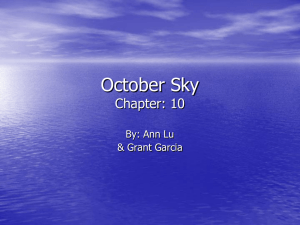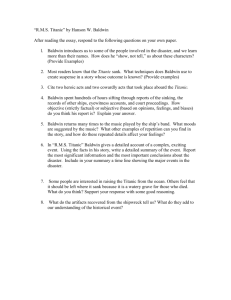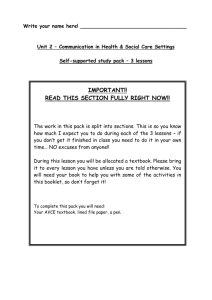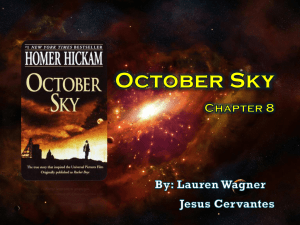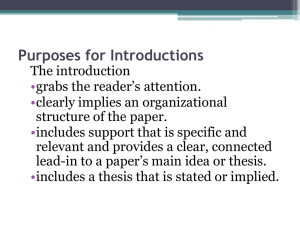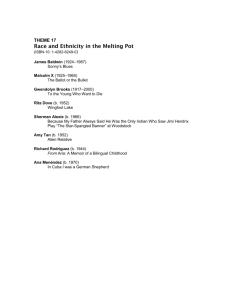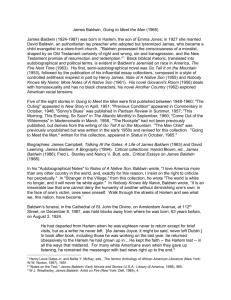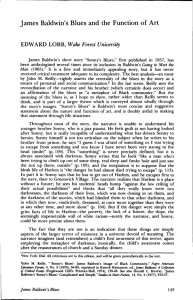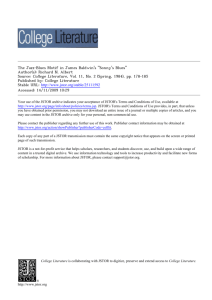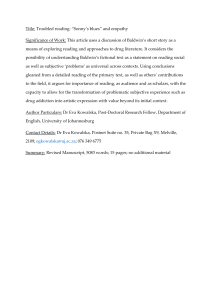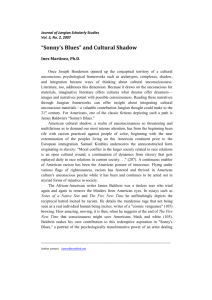handout - The University of Texas at Austin
advertisement
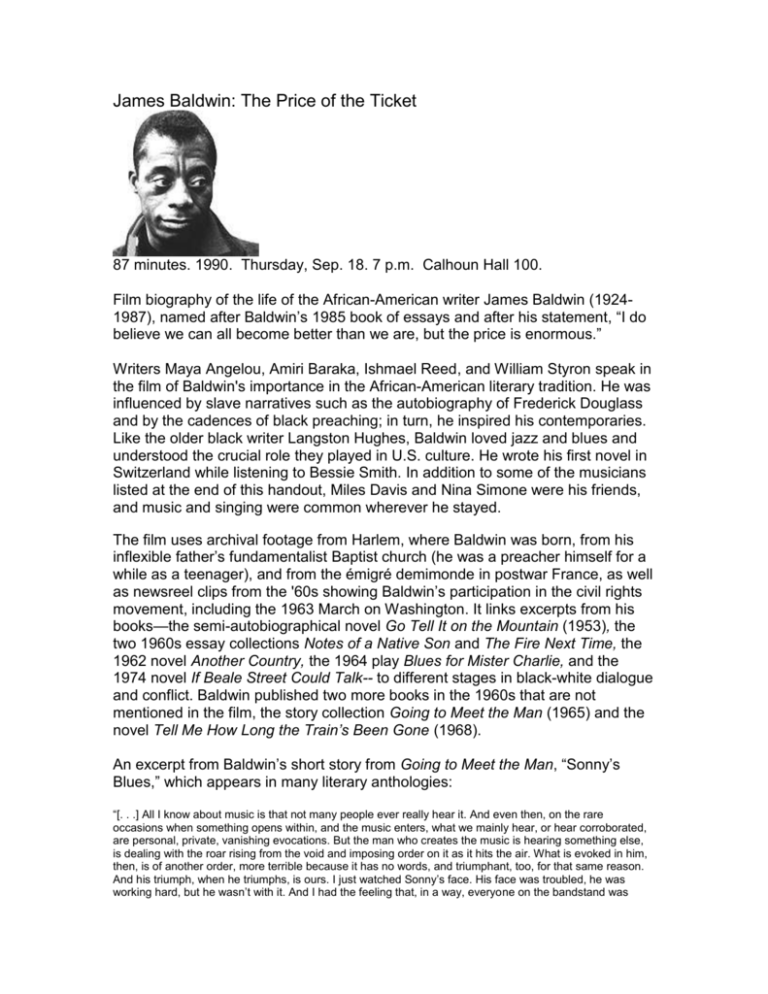
James Baldwin: The Price of the Ticket 87 minutes. 1990. Thursday, Sep. 18. 7 p.m. Calhoun Hall 100. Film biography of the life of the African-American writer James Baldwin (19241987), named after Baldwin’s 1985 book of essays and after his statement, “I do believe we can all become better than we are, but the price is enormous.” Writers Maya Angelou, Amiri Baraka, Ishmael Reed, and William Styron speak in the film of Baldwin's importance in the African-American literary tradition. He was influenced by slave narratives such as the autobiography of Frederick Douglass and by the cadences of black preaching; in turn, he inspired his contemporaries. Like the older black writer Langston Hughes, Baldwin loved jazz and blues and understood the crucial role they played in U.S. culture. He wrote his first novel in Switzerland while listening to Bessie Smith. In addition to some of the musicians listed at the end of this handout, Miles Davis and Nina Simone were his friends, and music and singing were common wherever he stayed. The film uses archival footage from Harlem, where Baldwin was born, from his inflexible father’s fundamentalist Baptist church (he was a preacher himself for a while as a teenager), and from the émigré demimonde in postwar France, as well as newsreel clips from the '60s showing Baldwin’s participation in the civil rights movement, including the 1963 March on Washington. It links excerpts from his books—the semi-autobiographical novel Go Tell It on the Mountain (1953), the two 1960s essay collections Notes of a Native Son and The Fire Next Time, the 1962 novel Another Country, the 1964 play Blues for Mister Charlie, and the 1974 novel If Beale Street Could Talk-- to different stages in black-white dialogue and conflict. Baldwin published two more books in the 1960s that are not mentioned in the film, the story collection Going to Meet the Man (1965) and the novel Tell Me How Long the Train’s Been Gone (1968). An excerpt from Baldwin’s short story from Going to Meet the Man, “Sonny’s Blues,” which appears in many literary anthologies: “[. . .] All I know about music is that not many people ever really hear it. And even then, on the rare occasions when something opens within, and the music enters, what we mainly hear, or hear corroborated, are personal, private, vanishing evocations. But the man who creates the music is hearing something else, is dealing with the roar rising from the void and imposing order on it as it hits the air. What is evoked in him, then, is of another order, more terrible because it has no words, and triumphant, too, for that same reason. And his triumph, when he triumphs, is ours. I just watched Sonny’s face. His face was troubled, he was working hard, but he wasn’t with it. And I had the feeling that, in a way, everyone on the bandstand was waiting for him, both waiting for him and pushing him along. But as I began to watch Creole, I realized that it was Creole who held them all back. He had them on a short rein. Up there, keeping the beat with his whole body, wailing on the fiddle, with his eyes half closed, he was listening to everything, but he was listening to Sonny. He was having a dialogue with Sonny. He wanted Sonny to leave the shoreline and strike out for the deep water. He was Sonny’s witness that deep water and drowning were not the same thing—he had been there, and he knew. And he wanted Sonny to know. He was waiting for Sonny to do the things on the keys which would let Creole know that Sonny was in the water. And, while Creole listened, Sonny moved, deep within, exactly like someone in torment. I had never before thought of how awful the relationship must be between the musician and his instrument. He has to fill it, this instrument, with the breath of life, his own. He has to make it do what he wants it to do. And a piano is just a piano. It’s made out of so much wood and wires and little hammers and big ones, and ivory. While there’s only so much you can do with it, the only way to find this out is to try; to try and make it do everything. And Sonny hadn’t been near a piano for over a year. And he wasn’t on much better terms with his life, not the life that stretched before him now. He and the piano stammered, started one way, got scared, stopped; started another way, panicked, marked time, started again; then seemed to have found a direction, panicked again, got stuck. And the face I saw on Sonny I’d never seen before. Everything had been burned out of it, and, at the same time, things usually hidden were being burned in, by the fire and fury of the battle which was occurring in him up there. Yet, watching Creole’s face as they neared the end of the first set, I had the feeling that something had happened, something I hadn’t heard. Then they finished, there was scattered applause, and then, without an instant’s warning, Creole started into something else, it was almost sardonic, it was Am I Blue. And, as though he commanded, Sonny began to play. Something began to happen. And Creole let out the reins. The dry, low, black man said something awful on the drums, Creole answered, and the drums talked back. Then the horn insisted, sweet and high, slightly detached perhaps, and Creole listened, commenting now and then, dry, and driving, beautiful and calm and old. Then they all came together again, and Sonny was part of the family again. I could tell this from his face. He seemed to have found, right there beneath his fingers, a damn brand-new piano. Then, for awhile, just being happy with Sonny, they seemed to be agreeing with him that brand-new pianos certainly were a gas. [. . .]” Blues for Mister Charlie showed a struggle between a character like Martin Luther King and a character like Malcolm X who said “All white men are Mr. Charlie.” His Martin Luther King character placed a gun on the pulpit and said, “Well, we have the Bible and the gun. One of these is going to work.” Baldwin did not shy away from articulating conflict, and so the sixties were hard for him. H e felt that he was living between assassinations. He explained eloquently what it was like growing up feeling that you have no country: that the Indian being killed by Gary Cooper in the Western film is you. He pointed out, “As long as you think you’re white, I’m going to be thinking I’m black.” The long essays “Down at the Cross,” published in The Fire Next Time (1963), and “No Name in the Street,” published in the book by that name in 1972, focus particularly on African-American political issues. One of his last works, the booklength essay The Evidence of Things Not Seen, focused on the Atlanta Child Murders of the early 1980s and the tragic problem of pressures and issues of race and showed that he did not seek easy solutions. The film explores his stays in Paris, the South of France, Istanbul, and Switzerland: places where Baldwin was able to write away from the racial tensions of the United States. Towards the end of his life, as his country turned its back on the challenge of racial justice, Baldwin became frustrated and sometimes enraged, but not bitter or desperate. His attitude was, “You’re always telling me [establishing justice] takes time. How much time do you want for your progress?” He kept writing and reaching out: "All men are brothers: That's the bottom line. If you can’t take it from there, you can’t take it at all.” “I think the trick is to say yes to life; love comes in very strange packages.” He had taken care of his eight younger siblings growing up, and wrote, “You can’t tell the children there’s no hope.” Baldwin was both a major twentieth century author and, for two crucial decades, a prophetic voice calling Americans, black and white, to confront the shared tragedy of their relationship. James Baldwin: The Price of the Ticket captures on film the passionate intellect and courageous writing of a man who was proud of being black, impoverished, gay, and gifted. Music from the film: “O Precious Lord,” arranged and sung by Baldwin himself “Motherless Child,” arranged by Odetta “Mournful Serenade,” Jelly Roll Morton “In a Sentimental Mood,” Duke Ellington and John Coltrane “Bloodcount,” Duke Ellington “Naima,” John Coltrane ”Why Do I Lie to Myself about You,” Fats Waller “Peace in Mississippi,” Jimi Hendrix “We Shall Not Be Moved,” The Freedom Singers This film will be shown in Celluloid for Social Justice: The Legacy of 1968 in Documentaries Mini-Film-Series Honoring the 40th Anniversary of California Newsreel; http://www.newsreel.org consisting of documentaries provided by California Newsreel The film series precedes 1968: A Global Perspective -An Interdisciplinary Conference at the University of Texas at Austin October 10-12, 2008; http://www.1968conf.org
